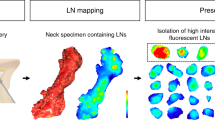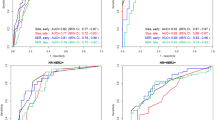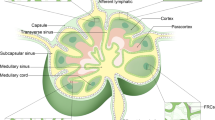Abstract
Lymph node biopsy is employed in many cancer surgeries to identify metastatic disease and to determine cancer stage, yet morbidity and diagnostic delays associated with lymph node biopsy could be avoided if noninvasive imaging of nodal involvement were reliable. Molecular imaging has potential in this regard; however, variable delivery and nonspecific uptake of imaging tracers have made conventional approaches ineffective clinically. Here we present a method of correcting for nonspecific uptake with injection of a second untargeted tracer that allows for quantification of tumor burden in lymph nodes. We confirmed the approach in an athymic mouse model of metastatic human breast cancer by targeting epidermal growth factor receptor, a cell surface receptor overexpressed by many cancers. We observed a significant correlation between in vivo (dual-tracer) and ex vivo measures of tumor burden (r = 0.97, P < 0.01), with an ultimate sensitivity of approximately 200 cells (potentially more sensitive than conventional lymph node biopsy).
This is a preview of subscription content, access via your institution
Access options
Subscribe to this journal
Receive 12 print issues and online access
$209.00 per year
only $17.42 per issue
Buy this article
- Purchase on Springer Link
- Instant access to full article PDF
Prices may be subject to local taxes which are calculated during checkout





Similar content being viewed by others
References
Chen, S.L., Iddings, D.M., Scheri, R.P. & Bilchik, A.J. Lymphatic mapping and sentinel node analysis: current concepts and applications. CA Cancer J. Clin. 56, 292–309; quiz 316–297 (2006).
Tobler, N.E. & Detmar, M. Tumor and lymph node lymphangiogenesis—impact on cancer metastasis. J. Leukoc. Biol. 80, 691–696 (2006).
Schrenk, P., Rieger, R., Shamiyeh, A. & Wayand, W. Morbidity following sentinel lymph node biopsy versus axillary lymph node dissection for patients with breast carcinoma. Cancer 88, 608–614 (2000).
Sampath, L., Wang, W. & Sevick-Muraca, E.M. Near infrared fluorescent optical imaging for nodal staging. J. Biomed. Opt. 13, 041312 (2008).
Reilly, R.M. et al. Problems of delivery of monoclonal antibodies. Pharmaceutical and pharmacokinetic solutions. Clin. Pharmacokinet. 28, 126–142 (1995).
Liu, J.T. et al. Quantifying cell-surface biomarker expression in thick tissues with ratiometric three-dimensional microscopy. Biophys. J. 96, 2405–2414 (2009).
Pogue, B.W. et al. Imaging targeted-agent binding in vivo with two probes. J. Biomed. Opt. 15, 030513 (2010).
Baeten, J., Haller, J., Shih, H. & Ntziachristos, V. In vivo investigation of breast cancer progression by use of an internal control. Neoplasia 11, 220–227 (2009).
Tichauer, K.M. et al. In vivo quantification of tumor receptor binding potential with dual-reporter molecular imaging. Mol. Imaging Biol. 14, 584–592 (2012).
Davis, S.C. et al. Dynamic dual-tracer MRI-guided fluorescence tomography to quantify receptor density in vivo. Proc. Natl. Acad. Sci. USA 110, 9025–9030 (2013).
Saltz, L.B. et al. Phase II trial of cetuximab in patients with refractory colorectal cancer that expresses the epidermal growth factor receptor. J. Clin. Oncol. 22, 1201–1208 (2004).
Nicholson, R.I., Gee, J.M. & Harper, M.E. EGFR and cancer prognosis. Eur. J. Cancer 37 (suppl. 4), S9–S15 (2001).
van Agthoven, T., Timmermans, M., Dorssers, L.C. & Henzen-Logmans, S.C. Expression of estrogen, progesterone and epidermal growth factor receptors in primary and metastatic breast cancer. Int. J. Cancer 63, 790–793 (1995).
Wei, Q. et al. EGFR, HER2, and HER3 expression in laryngeal primary tumors and corresponding metastases. Ann. Surg. Oncol. 15, 1193–1201 (2008).
Wei, Q. et al. EGFR, HER2 and HER3 expression in esophageal primary tumours and corresponding metastases. Int. J. Oncol. 31, 493–499 (2007).
Shen, L. et al. EGFR and HER2 expression in primary cervical cancers and corresponding lymph node metastases: implications for targeted radiotherapy. BMC Cancer 8, 232 (2008).
Carlsson, J., Shen, L., Xiang, J., Xu, J. & Wei, Q. Tendencies for higher co-expression of EGFR and HER2 and downregulation of HER3 in prostate cancer lymph node metastases compared with corresponding primary tumors. Oncology Lett. 5, 208–214 (2013).
Bue, P. et al. Expression of epidermal growth factor receptor in urinary bladder cancer metastases. Int. J. Cancer 76, 189–193 (1998).
Italiano, A. et al. Epidermal growth factor receptor (EGFR) status in primary colorectal tumors correlates with EGFR expression in related metastatic sites: biological and clinical implications. Ann. Oncol. 16, 1503–1507 (2005).
Real, F.X. et al. Expression of epidermal growth factor receptor in human cultured cells and tissues: relationship to cell lineage and stage of differentiation. Cancer Res. 46, 4726–4731 (1986).
Kern, K.A. Sentinel lymph node mapping in breast cancer using subareolar injection of blue dye. J. Am. Coll. Surg. 189, 539–545 (1999).
Brader, P. et al. Imaging of lymph node micrometastases using an oncolytic herpes virus and [F]FEAU PET. PLoS ONE 4, e4789 (2009).
Tafreshi, N.K. et al. Noninvasive detection of breast cancer lymph node metastasis using carbonic anhydrases IX and XII targeted imaging probes. Clin. Cancer Res. 18, 207–219 (2012).
Tafreshi, N.K. et al. A mammaglobin-A targeting agent for noninvasive detection of breast cancer metastasis in lymph nodes. Cancer Res. 71, 1050–1059 (2011).
Savariar, E.N. et al. Real-time in vivo molecular detection of primary tumors and metastases with ratiometric activatable cell-penetrating peptides. Cancer Res. 73, 855–864 (2013).
Weaver, D.L. Pathology evaluation of sentinel lymph nodes in breast cancer: protocol recommendations and rationale. Mod. Pathol. 23 (suppl. 2), S26–S32 (2010).
Sexton, K. et al. Pulsed-light imaging for fluorescence guided surgery under normal room lighting. Opt. Lett. 38, 3249–3252 (2013).
Porter, C.J. & Charman, S.A. Lymphatic transport of proteins after subcutaneous administration. J. Pharm. Sci. 89, 297–310 (2000).
Gerlinger, M. et al. Intratumor heterogeneity and branched evolution revealed by multiregion sequencing. N. Engl. J. Med. 366, 883–892 (2012).
Hettiarachchi, K., Kim, H. & Faris, G.W. Optical manipulation and control of real-time PCR in cell encapsulating microdroplets by IR laser. Microfluid. Nanofluid. 13, 967–975 (2012).
Liebert, A. et al. Time-resolved multidistance near-infrared spectroscopy of the adult head: intracerebral and extracerebral absorption changes from moments of distribution of times of flight of photons. Appl. Opt. 43, 3037–3047 (2004).
Zhu, Q. et al. Benign versus malignant breast masses: optical differentiation with US-guided optical imaging reconstruction. Radiology 237, 57–66 (2005).
Flynn, B.P., Dsouza, A.V., Kanick, S.C., Davis, S.C. & Pogue, B.W. White light-informed optical properties improve ultrasound-guided fluorescence tomography of photoactive protoporphyrin IX. J. Biomed. Opt. 18, 046008 (2013).
Koral, K.F. et al. SPECT dual-energy-window Compton correction: scatter multiplier required for quantification. J. Nucl. Med. 31, 90–98 (1990).
Jenkins, D.E., Hornig, Y.S., Oei, Y., Dusich, J. & Purchio, T. Bioluminescent human breast cancer cell lines that permit rapid and sensitive in vivo detection of mammary tumors and multiple metastases in immune deficient mice. Breast Cancer Res. 7, R444–R454 (2005).
Contag, C.H., Jenkins, D., Contag, P.R. & Negrin, R.S. Use of reporter genes for optical measurements of neoplastic disease in vivo. Neoplasia 2, 41–52 (2000).
Reilly, R.M. et al. A comparison of EGF and MAb 528 labeled with 111In for imaging human breast cancer. J. Nucl. Med. 41, 903–911 (2000).
Peng, X. et al. Phthalocyanine dye as an extremely photostable and highly fluorescent near-infrared labeling agent. Proc. SPIE 6097, 19 (2006).
Wu, F. et al. Fluorescence imaging of the lymph node uptake of proteins in mice after subcutaneous injection: molecular weight dependence. Pharm. Res. 29, 1843–1853 (2012).
Alcoser, S.Y. et al. Real-time PCR-based assay to quantify the relative amount of human and mouse tissue present in tumor xenografts. BMC Biotechnol. 11, 124 (2011).
Becker, M. et al. Sensitive PCR method for the detection and real-time quantification of human cells in xenotransplantation systems. Br. J. Cancer 87, 1328–1335 (2002).
Hamzei, N. et al. Comparison of kinetic models for dual-tracer receptor concentration imaging in tumors. Austin J. Biomed. Eng. 1, 9 (2014).
Samkoe, K.S. et al. High vascular delivery of EGF, but low receptor binding rate is observed in AsPC-1 tumors as compared to normal pancreas. Mol. Imaging Biol. 14, 472–479 (2012).
Tichauer, K.M. et al. Tumor endothelial marker imaging in melanomas using dual-tracer fluorescence molecular imaging. Mol. Imaging Biol. 16, 372–382 (2014).
Tichauer, K.M. et al. Accounting for pharmacokinetic differences in dual-tracer receptor density imaging. Phys. Med. Biol. 59, 2341–2351 (2014).
Tichauer, K.M., Samkoe, K.S., Klubben, W.S., Hasan, T. & Pogue, B.W. Advantages of a dual-tracer model over reference tissue models for binding potential measurement in tumors. Phys. Med. Biol. 57, 6647–6659 (2012).
Tichauer, K.M. et al. Improved tumor contrast achieved by single time point dual-reporter fluorescence imaging. J. Biomed. Opt. 17, 066001 (2012).
Lammertsma, A.A. & Hume, S.P. Simplified reference tissue model for PET receptor studies. Neuroimage 4, 153–158 (1996).
Innis, R.B. et al. Consensus nomenclature for in vivo imaging of reversibly binding radioligands. J. Cereb. Blood Flow Metab. 27, 1533–1539 (2007).
Jacques, S.L. Optical properties of biological tissues: a review. Phys. Med. Biol. 58, R37–R61 (2013).
Ichise, M. et al. Linearized reference tissue parametric imaging methods: application to [11C]DASB positron emission tomography studies of the serotonin transporter in human brain. J. Cereb. Blood Flow Metab. 23, 1096–1112 (2003).
Lammertsma, A.A. et al. Comparison of methods for analysis of clinical [11C]raclopride studies. J. Cereb. Blood Flow Metab. 16, 42–52 (1996).
Kety, S.S. The theory and applications of the exchange of inert gas at the lungs and tissues. Pharmacol. Rev. 3, 1–41 (1951).
Patel, D. et al. Monoclonal antibody cetuximab binds to and down-regulates constitutively activated epidermal growth factor receptor vIII on the cell surface. Anticancer Res. 27, 3355–3366 (2007).
Acknowledgements
This work was sponsored by US National Institutes of Health research grants R01 CA109558, R01 CA156177, and U54 CA151662 as well as a the Canadian Institutes of Health Research postdoctoral fellowship for K.M.T.
Author information
Authors and Affiliations
Contributions
K.M.T. designed the experiments, developed the kinetic modeling methodology, carried out the experiments, analyzed all imaging data and wrote the paper. K.S.S. helped design the experiments and validation procedure and helped write the paper. J.R.G. carried out much of the animal imaging and carried out all qPCR and bioluminescence imaging. S.C.K. carried out photon propagation simulations. P.J.H. analyzed all H&E stains. R.J.B. and P.A.K. provided clinical support for design and direction of the study. T.H. helped supervise the project. B.W.P. provided full support for the project and gave substantial feedback on all aspects of the project.
Corresponding authors
Ethics declarations
Competing interests
The authors declare no competing financial interests.
Rights and permissions
About this article
Cite this article
Tichauer, K., Samkoe, K., Gunn, J. et al. Microscopic lymph node tumor burden quantified by macroscopic dual-tracer molecular imaging. Nat Med 20, 1348–1353 (2014). https://doi.org/10.1038/nm.3732
Received:
Accepted:
Published:
Issue Date:
DOI: https://doi.org/10.1038/nm.3732
This article is cited by
-
Identification of a Suitable Untargeted Agent for the Clinical Translation of ABY-029 Paired-Agent Imaging in Fluorescence-Guided Surgery
Molecular Imaging and Biology (2023)
-
Novel multifunctional NIR-II aggregation-induced emission nanoparticles-assisted intraoperative identification and elimination of residual tumor
Journal of Nanobiotechnology (2022)
-
Quantitative hypoxia mapping using a self-calibrated activatable nanoprobe
Journal of Nanobiotechnology (2022)
-
Fluorescence grid analysis for the evaluation of piecemeal surgery in sinonasal inverted papilloma: a proof-of-concept study
European Journal of Nuclear Medicine and Molecular Imaging (2022)
-
A novel targeted multifunctional nanoplatform for visual chemo-hyperthermia synergy therapy on metastatic lymph nodes via lymphatic delivery
Journal of Nanobiotechnology (2021)



